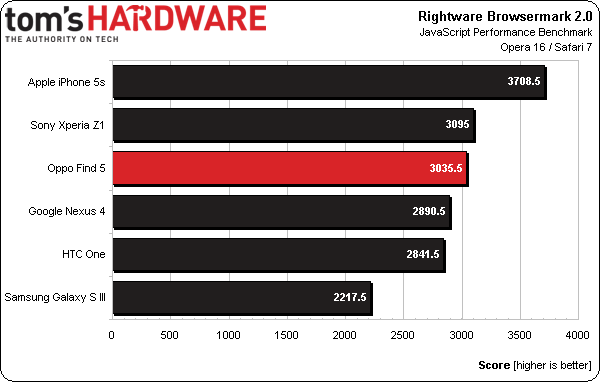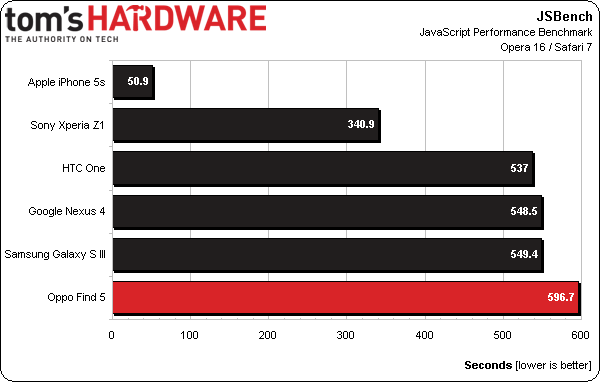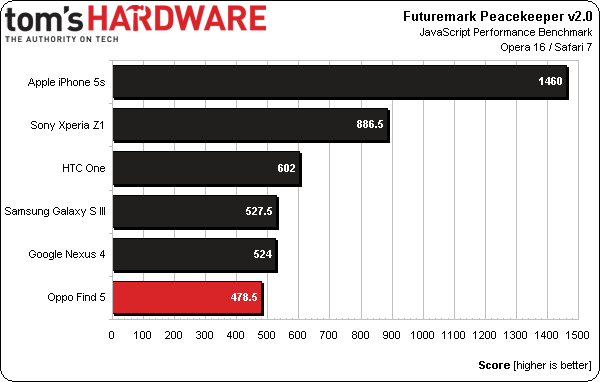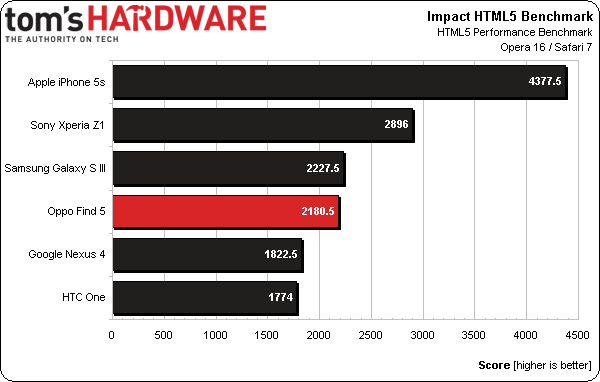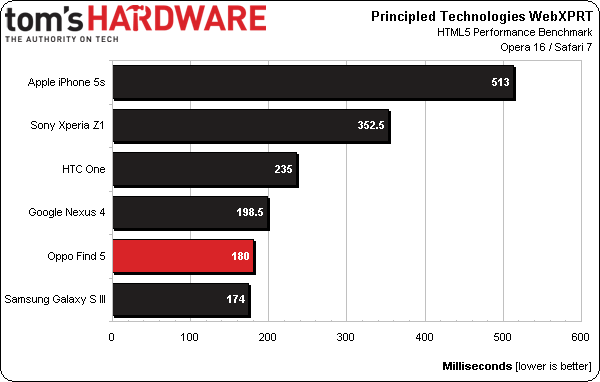Oppo Find 5 Review: A Phone Of Firsts From A Brand To Watch
Has a relatively unknown Chinese manufacturer of high-end home theater equipment actually created a flagship Android smartphone capable of going head to head with the industry's established heavyweights? We take Oppo's S4 Pro-powered Find 5 for a spin.
Results: Web Tests
Our Web benchmarks employ a number of Javascript- and HTML5-heavy tests from our Web Browser Grand Prix series, which is particularly relevant for mobile platforms since the vast majority of in-app content is delivered by the respective browser back-end. Since web browsing tasks are traditionally CPU dependent, this suite of browser benchmarks should provide an ideal method to measure SoC performance on devices using the same browser and platform.
Our test methodology for this section aims to mitigate the impact of browser versions and ensure consistent results across the respective platforms, hence we chose to use a standard version of the Chromium-based Opera 16 browser for all Android devices. Since iOS limits our choice to Safari and we are unable to easily force versioning on that platform, the iPhone 5s is included as a reality check or sorts, not as a direct CPU-to-CPU comparison to the Android devices.
JavaScript
Starting off our tests is Rightware’s BrowserMark 2.0, a synthetic browsing benchmark that tests several aspects of performance including: load time, CSS, DOM, HTML5 Canvas, JavaScript, and WebGL.
The Apple iPhone 5s comfortably takes the lead in this test. The Find 5, which previously performed less-than-optimally due to its Android 4.1.1 OS and FHD resolution, improves in this test, appearing just behind the more powerful Sony Xperia Z1. As for the HTC One, the device continues to suffer from its HTC Sense ROM.
Next up, we have JSBench, the spiritual successor to WebKit's ubiquitous SunSpider test. Unlike most synthetic browser benchmarks, JSBench comes close to measuring real world performance since the test utilizes segments of JavaScript that are present in a number of popular Web sites.
Unsurprisingly, the iPhone 5s absolutely dominates the JSBench test as a result of both its 64-bit ARM A7 SoC and iOS' native thread boosting for the HTML engine (also a likely reason why the OS is restricted to Safari). Moving onto the Android platform, the Xperia Z1 tops the chart with a resounding margin over the HTC One. Although it's easy to point to the phone's powerful Snapdragon 800 SoC as the explanation for its performance, Sony was one of the first to optimize for the Krait architecture with its first-generation Xperia smartphones, so it’s likely these optimizations carry forward into the company's current device line-up.
The Find 5's poor performance in this test can once again be attributed to its Android 4.1.1 operating system and substantial quantity of "live" content that is simply not present in the Galaxy S3's version of Android 4.0.4.
Get Tom's Hardware's best news and in-depth reviews, straight to your inbox.
Peacekeeper is a synthetic Javascript performance benchmark from Futuremark, makers of 3DMark and PCMark.
Peacekeeper's JavaScript test provides the same results as JSBench, consequently our observations from that benchmark are fully applicable here as well.
HTML5
We commence our range of HTML5 tests with the Impact HTML5 Benchmark, which is essentially a time demo of the Impact HTML5 game engine. This test should provide an indication of each device's performance in most HTML5-based platformers.
As seen in the JavaScript tests, the iPhone 5s is comfortably ahead of the Android-based handsets due to its A7 SoC and iOS' built-in thread-boosting engine. The biggest surprise from this benchmark is of course the Samsung Galaxy S3, which comes in third place overall, despite being powered by the weakest and oldest SoC in our comparison. Since we have no way to control voltages or detect voltage boosting in the kernel at this time, we can only conclude that the S3's remarkable performance has come as a result of Samsung's HTML5 optimizations.
The Impact HTML5 test also provides another indication of the HTC One's relative lack of memory due to HTC Sense. The device comes in last place in spite of its Snapdragon 600 being the third most powerful SoC on paper.
Finally, we have Principled Technologies' WebXPRT, an HTML5-based Web app benchmark. This test simulates common productivity tasks that are traditionally handled by locally-installed applications, including photo editing, financial charting, and offline note-taking.
Although WebXPRT seems significantly more focused on math throughput and consequently allows the Snapdragon 600 to perform much better, the test essentially duplicates Impact HTML5. Consequently, we continue to see the dominance of the iPhone 5s and the excellent performance from the Xperia Z1 and its Snapdragon 800 SoC.
Current page: Results: Web Tests
Prev Page Results: Graphics Tests Next Page Results: Display MeasurementsTarun Iyer was a contributor for Tom's Hardware who wrote news covering a wide range of technology topics, including processors, graphics cards, cooling systems, and computer peripherals. He also covered tech trends such as the development of adaptive all-in-one PCs.
